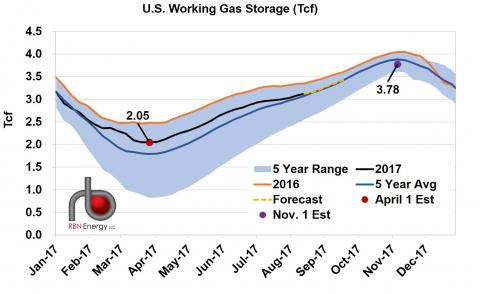Which way is the wind blowing in California?
In some respects, wind energy in the state has never been better, but by other measurements growth has hit a lull for the past four years.
The U.S. Department of Energy released its annual report a few weeks ago analyzing technologies and markets for the wind industry, showing that California has installed 5,656 megawatts of utility-scale wind, the fourth highest in the nation [trailing Texas by a huge margin, and even "beaten" by that little midwestern state, Iowa].
Installed capacity for wind energy, measured in megawatts, 2016:
1. Texas 20,320Note: this is "installed capacity." About 20% of that is actually delivered/used. Meanwhile, plants with reliable nuclear energy, coal, and natural gas must remain "on" to provide necessary back up when the wind is not blowing.
2. Iowa 6,911
3. Oklahoma 6,645
4. California 5,656
5. Kansas 4,451
**********************************
And While California Dithers, Texas Keeps Adding
Data points at PennEnergy:
- NextEra Energy Resources; two established wind farms
- will upgrade turbines
- supplier: Siemens Gamesa Reewable Energy (SGRE)
- should deliver 25% more annual energy production; boost reliability and efficiency; and, extend service life
*******************************
Shell Opens First Service Station In Mexico
From Reuters, data points:
- Anglo-Dutch oil major Royal Dutch Shell opened first gas station in Mexico today (Tuesdsay)
- ends Pemex' decades-long monopoly
- private companies can now brand gas stations; sell non-Pemex brand gasoline and diesel, as well as import fuels;
- opportunities are huge for the private sector: looks like Shell jumped in first
- Mexico
- Latin America's second-biggest economy (2nd to Brazil, I suppose)
- one of the world's biggest gasoline consumers
- top foreign importer of US gasoline
- Shell said it's investment in Mexico could reach $1 billion
*********************************
Ohio Getting Ready For Tesla
Coal, nuclear want state subsidies, grants, tax credits -- whatever it takes to stay in business.
Meanwhile, a wave of natural gas plants to produce electricity are waiting in the wings, waiting to see whether Ohio underwrites their nuclear, coal industry:
- the new plant, near Toledo, OH
- only requires two workers per shift; significantly less than what coal, nuclear plants require
- $800 million natural gas plant; opened two weeks ago
- located near the booming natural gas fields in the Utica / Marcellus
- developed by Boston-based Clean Energy Future LLC; has three more plants in the works; says the state has room for 15 natural gas plants within the next decade
- currently, close to a dozen natural gas power plants are being built or are in the planning stages
*********************************
US To Be Net Exporter of Oil By 2023
Saudi in Deep Doo Doo
The Birth of the Pill:
How Four Crusaders Reinvented Sex and Launched a Revolution
Jonathan Eig
c. 2014
The first birth control pill, I believe, was Enovid (Searle). Page 258 of Eig's book:
Saudi in Deep Doo Doo
Link here. Data points:
- if oil trade with Canada is excluded, the "2023" date moves to 2019 -- that's barely two years from now
- one word: shale
- net oil imports peaked in 2005 at 12.5 million b/d; will fall to 4.4 million b/d this year
- US currently imports 7 million b/d: 3 from Canada; 2 each from Latin America and Middle East
- analysts export US net oil exports to reach 3.3 million b/d 2031
The Birth of the Pill:
How Four Crusaders Reinvented Sex and Launched a Revolution
Jonathan Eig
c. 2014
I first saw the softcover book at Barnes and Noble a few weeks ago, paged through it, saw the names of several individuals involved in the project, thought it would be a good read, and ordered it from Amazon (along with some other books already in the "cart'). Meanwhile, some days later, and this is the unvarnished truth, I was looking for a "science" book at the local library and the biography of Margaret Sanger jumped out at me. Okay, not literally.
So, I guess I'm in my Margaret Sanger phase. I've read the biography (from the library); notes are here.
We take the "pill" for granted these days but for anyone coming of age in the 1960s and 1970s it's hard to think of something that was more life-altering.
I was a teen-ager / 20-something right in the middle of the sexual revolution, and completely unaware of all that was going one, particularly the social implications. I was too involved in academics. That all changed between 1973 and 1977 through a whirlwind of events.
It was really quite remarkable. At the time I never had any idea what was going on. I'm not sure many did. It was something about which was seldom discussed. It appears that Jonathan Eig has written a really good history of that decade -- actually several decades, of course -- based on the few pages I've read.
The first birth control pill, I believe, was Enovid (Searle). Page 258 of Eig's book:
On June 10, 1957, after taking two months to review the application filed by G. D. Searle & Co., the FDA approved the sale of Enovid for infertility and menstrual irregularities. At about the same time, the drug was approved for the same used in England under the brand name Enavid.
The drug was being marketed in West Africa, particularly, to help women become pregnant.


